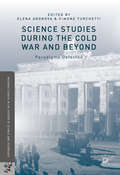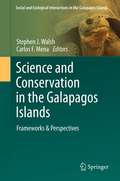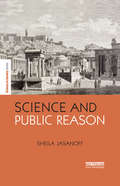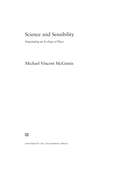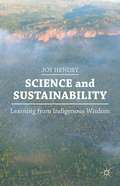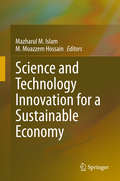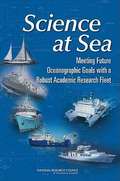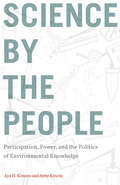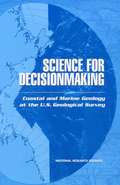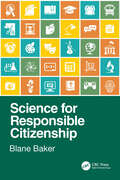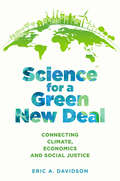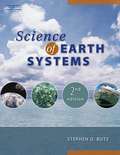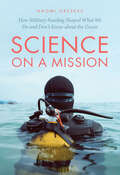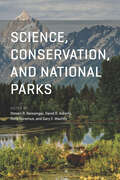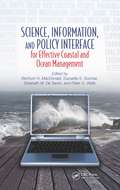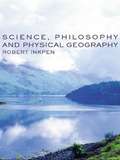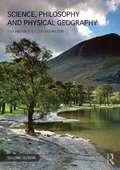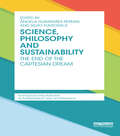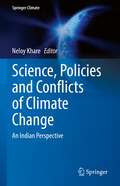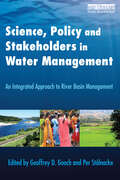- Table View
- List View
Science Studies during the Cold War and Beyond
by Simone Turchetti Elena AronovaThis book recounts how during the Cold War the study of science moved to the centre of academic through the creation of the new discipline of science studies. In this way the volume charts the importance of these studies for the trajectory of Cold War nations through the elaboration of new national science policies and the transnational dialogue, even across the Iron Curtain, between key scholars involved in shaping their trajectory. By examining how a new group of intellectuals was mobilized by state administrators to convincingly set up a discipline deemed to have major repercussions on the advancement of science in developed and undeveloped nations. Secondly, by putting the study of science at the centre of the dialogue (as well as the confrontation) between nations and Cold War blocs. The volume thus shows how an often considered arcane field of enquiring had in fact major implications for the understanding and fostering of Cold War science.
Science and Conservation in the Galapagos Islands
by Stephen J. Walsh Carlos F. MenaIn this launch of the Galapagos series, this book provides a broad "framing" assessment of the current status of social and ecological systems in the Galapagos Islands, and the feedback that explicitly links people to the environment. It also highlights the challenges to conservation imposed by tourism in the Galapagos Islands and the attendant migration of people from mainland Ecuador to service the burgeoning tourism industry. Further, there is an emphasize on the status of the terrestrial and marine environments that form the very foundation of the deep attraction to the Islands by tourists, residents, scholars, and conservationists.
Science and Conservation of Vernal Pools in Northeastern North America: Ecology and Conservation of Seasonal Wetlands in Northeastern North America
by Aram J. Calhoun Phillip G. DeMaynadierSynthesizes Decades of Research on Vernal Pools SciencePulling together information from a broad array of sources, Science and Conservation of Vernal Pools in Northeastern North America is a guide to the issues and solutions surrounding seasonal pools. Drawing on 15 years of experience, the editors have mined published literature,
Science and Public Reason (The Earthscan Science in Society Series)
by Sheila JasanoffThis collection of essays by Sheila Jasanoff explores how democratic governments construct public reason, that is, the forms of evidence and argument used in making state decisions accountable to citizens. The term public reason as used here is not simply a matter of deploying principled arguments that respect the norms of democratic deliberation. Jasanoff investigates what states do in practice when they claim to be reasoning in the public interest. Reason, from this perspective, comprises the institutional practices, discourses, techniques and instruments through which governments claim legitimacy in an era of potentially unbounded risks—physical, political, and moral. Those legitimating efforts, in turn, depend on citizens’ acceptance of the forms of reasoning that governments offer. Included here therefore is an inquiry into the conditions that lead citizens of democratic societies to accept policy justification as being reasonable. These modes of public knowing, or “civic epistemologies,” are integral to the constitution of contemporary political cultures. Methodologically, the book is grounded in the field of Science and Technology Studies (STS). It uses in-depth qualitative studies of legal and political practices to shed light on divergent cross-cultural constructions of public reason and the reasoning political subject. The collection as a whole contributes to democratic theory, legal studies, comparative politics, geography, and ethnographies of modernity, as well as STS.
Science and Sensibility: Negotiating an Ecology of Place
by Michael Vincent McginnisIf humans are to understand and discover ways of addressing complex social and ecological problems, we first need to find intimacy with our particular places and communities. Cultivating a relationship to place often includes a negotiating process that involves both science and sensibility. While science is one key part of an adaptive and resilient society, the cultivation of a renewed sense of place and community is essential as well. Science and Sensibility argues for the need for ecology to engage with philosophical values and economic motivations in a political process of negotiation, with the goal of shaping humans' treatment of the natural world. Michael Vincent McGinnis aims to reframe ecology so it might have greater "trans-scientific" awareness of the roles and interactions among multiple stakeholders in socioecological systems, and he also maintains that deep ecological knowledge of specific places will be crucial to supporting a sustainable society. He uses numerous specific case studies from watershed, coastal, and marine habitats to illustrate how place-based ecological negotiation can occur, and how reframing our negotiation process can influence conservation, restoration, and environmental policy in effective ways.
Science and Sustainability
by Joy HendryIndigenous science is often dismissed as quackery or nonsense, out of touch with progress and current events. However, Indigenous peoples have passed down vital information for generations, from which local plants help cure common ailments, to which parts of the land are unsuitable for buildings because of likely earthquakes. These scientific practices that have been developed by Indigenous peoples around the world have been largely ignored by Western colonizers in their lands. From Japan and New Zealand to Australia and Canada, Indigenous science involves environmentally-focused, sustainable practices that allow people to live with the land rather than in spite of it. Here, Hendry examines science through these Indigenous roots, problematizing the idea that Western science is the only type that deserves that name and drawing attention to some of its shortcomings. She takes the reader with her on the learning process and shares a myriad of sustainable examples that can be put into practice.
Science and Technology Innovation for a Sustainable Economy
by Mazharul M. Islam M. Moazzem HossainThis book discusses the subject of pathways to a sustainable economy through science and technology innovations which are regarded as the important components of the ‘4th Industrial Revolution’. The volume has been developed from Bangladesh’s ‘Vision 2041’ agenda which includes development actions needed to catch up with more developed nations. Most importantly, the goals of the ‘Vision 2041’ have been taken from the dreams of the architect of independent Bangladesh, Bangabandhu (Friends of Bengal) Sheikh Mujibur Rahman. His dream was to make Bangladesh the Switzerland of Asia. The Father of Bangladesh Nation was killed by assassins’ bullets along with his most of the family members in August 1975. After his death, the nation moved backwards while recovering from nine months of liberation post war in 1971.Between 1975 and 1990 Bangladesh was ruled by military and quasi military governments. Bangladesh established a true democratic regime in 1996 with Sheikh Mujib’s daughter, Sheikh Hasina, who formed the government after 21 years with a mandate to realise the dreams of her father. Sheikh Hasina, had her own 20 year vision for Bangladesh, called, ‘Vision 2021’, with plans to make the nation poverty free by 2021. After a pause between 2001 and 2008, Sheikh Hasina returned to power in 2009. Under her consecutive three terms she brought Bangladesh back on track and Bangladesh is one of the nations which reduced poverty half under MDGs by 2015. During her third consecutive term Sheikh Hasina, is on the way to transforming Bangladesh into a ‘middle income’ nation by 2021. This volume aims to identify and mitigate the challenges of ‘4th Industrial Revolution’ investigating the areas of science and technology innovations for Bangladesh and for other parts of the world keeping in mind establishing a sustainable economy under UN agendas to 2030 (SDGs). The primary audience for this book are UN development agencies, academic institutions, government policymakers and business leaders of the more developed and developing nations alike.
Science and Technology for DOE Site Cleanup: Workshop Summary
by National Research Council of the National AcademiesThe Department of Energy's Office of Environmental Management is developing a technology roadmap to guide planning and possible future congressional appropriations for its technology development programs. It asked the National Research Council of the National Academies to provide technical and strategic advice to support the development and implementation of this roadmap, specifically by undertaking a study that identifies principal science and technology gaps and their priorities for the cleanup program based on previous National Academies reports, updated and extended to reflect current site conditions and EM priorities and input form key external groups, such as the Nuclear Regulatory Commission, Defense Nuclear Facilities Safety Board, Environmental Protection Agency, and state regulatory agencies. In response, this book provides a high-level synthesis of principal science and technology gaps identified in previous NRC reports in part 1. Part 2 summarizes a workshop meant to bring together the key external groups to discuss current site conditions and science and technology needs.
Science as a Contact Sport: Inside the Battle to Save Earth's Climate
by Stephen H. SchneiderA member of the Intergovernmental Panel on Climate Change that won the 2007 Nobel Peace Prize, Schneider (interdisciplinary environmental studies and biology, Stanford U.) draws on his own participation and other sources to trace the campaign to recognize and address climate change over the past four decades. His topics include smoke on the horizon, a fragile planet grows alarmed, the battle heats up and so does the world, the stories behind persistent distortion in the media, and what should keep people awake at night. Annotation ©2010 Book News, Inc., Portland, OR (booknews.com)
Science at Sea: Meeting Future Oceanographic Goals with a Robust Academic Research Fleet
by National Research Council of the National AcademiesThe U.S. academic research fleet is an essential national resource, and it is likely that scientific demands on the fleet will increase. Oceanographers are embracing a host of remote technologies that can facilitate the collection of data, but will continue to require capable, adaptable research vessels for access to the sea for the foreseeable future. Maintaining U.S. leadership in ocean research will require investing in larger and more capable general purpose Global and Regional class ships; involving the scientific community in all phases of ship design and acquisition; and improving coordination between agencies that operate research fleets.
Science by the People: Participation, Power, and the Politics of Environmental Knowledge (Nature, Society, and Culture)
by Aya H. Kimura Abby KinchyCitizen science—research involving nonprofessionals in the research process—has attracted both strong enthusiasts and detractors. Many environmental professionals, activists, and scholars consider citizen science part of their toolkit for addressing environmental challenges. Critics, however, contend that it represents a corporate takeover of scientific priorities. In this timely book, two sociologists move beyond this binary debate by analyzing the tensions and dilemmas that citizen science projects commonly face. Key lessons are drawn from case studies where citizen scientists have investigated the impact of shale oil and gas, nuclear power, and genetically engineered crops. These studies show that diverse citizen science projects face shared dilemmas relating to austerity pressures, presumed boundaries between science and activism, and difficulties moving between scales of environmental problems. By unpacking the politics of citizen science, this book aims to help people negotiate a complex political landscape and choose paths moving toward social change and environmental sustainability.
Science for Decisionmaking: Coastal and Marine Geology at the U.S. Geological Survey
by Ocean Studies BoardThe coastlines of the United States are beautiful places to live, work and play. But, they are also very fragile areas whose ecosystems are vulnerable to mismanagement. There are many complex issues facing the ocean science community at the federal, state and local levels - this report reflects the conclusions and recommendations of the National Academies drawing on discussions with USGS as well as input from potential users, clients and collaborators of the Coastal and Marine Geology Program.
Science for Responsible Citizenship
by Blane BakerScience for Responsible Citizenship helps the reader to understand how science works and how science can help us develop reasonable and logical solutions to worldwide problems. Basic science knowledge and possible solutions based on scientific reasoning are explored, with a focus on interdisciplinary topics including disease transmission, energy, and climate change. The book starts with discussing the role of science in modern society, before tackling the basic science of global warming, human health, chemical processes that contribute to life on Earth, and the importance of water. The second half of the book describes the science of the electrical grid, nuclear reactions, devices and reactors, the Earth’s habitability, electronics, and optics, and concludes with a look ahead at the scientific and technological challenges of future energy needs and sustainable energy. This book can be used as part of a general science course at the college level and is also accessible to anyone with a high school background.Key Features: Addresses the fundamentals of scientific knowledge and reasoning in a clear and accessible style Offers a timely exploration of several existential challenges that can be addressed by science Provokes and encourages thought on how to solve some of our global problems
Science for a Green New Deal: Connecting Climate, Economics, and Social Justice
by Eric A. DavidsonScience, not politics, can take us beyond the hype and headlines to forge a realistic green new deal.Since it was first proposed in the US House of Representatives, the Green New Deal has been hotly debated, often using partisan characterizations that critique it as extreme or socialist. The intent was not simply to fight climate change or address a specific environmental concern, but rather to tackle how climate change and other environmental challenges affect the economy, the vulnerable, and social justice—and vice versa. In Science for a Green New Deal, Eric Davidson dissects this legislative resolution. He also shows how green new deal thinking offers a framework for a much-needed convergence of the natural sciences, social science, economics, and community engagement to develop holistic policy solutions to the most pressing issues of our day. Davidson weaves the case for linkages among multiple global crises, including a pandemic that has reversed progress on fighting poverty and hunger, an acceleration of climate change that has exacerbated storms, floods, droughts, and fires, and a renewed awareness of profound social injustices highlighted by the Black Lives Matter movement.Illustrating these points with his personal life experiences as a child growing up in Montana and as a famed researcher leading a large scientific society, Davidson relates these complex challenges to our everyday lives and decision-making. How, he asks, can we extract from the Earth's resources what we need for the prosperity, well-being, and dignity of current and future generations of billions of people without exhausting or polluting those resources? Written in clear, jargon-free prose, Science for a Green New Deal is a realistic and optimistic look at how we can attain a more sustainable, prosperous, and just future.
Science in History: Cultures of Botany in Britain and France, 1760–1815 (Science in History)
by Sarah Easterby-SmithSarah Easterby-Smith rewrites the histories of botany and horticulture from the perspectives of plant merchants who sold botanical specimens in the decades around 1800. These merchants were not professional botanists, nor were they the social equals of refined amateurs of botany. Nevertheless, they participated in Enlightenment scholarly networks, acting as intermediaries who communicated information and specimens. Thanks to their practical expertise, they also became sources of new knowledge in their own right. Cultivating Commerce argues that these merchants made essential contributions to botanical history, although their relatively humble status means that their contributions have received little sustained attention to date. Exploring how the expert nurseryman emerged as a new social figure in Britain and France, and examining what happened to the elitist, masculine culture of amateur botany when confronted by expanding public participation, Easterby-Smith sheds fresh light on the evolution of transnational Enlightenment networks during the Age of Revolutions.
Science of Earth Systems
by Stephen D. ButzScience of Earth Systems, second sdition is designed to introduce the new scientific discipline of Earth System Science to secondary school students.
Science on a Mission: How Military Funding Shaped What We Do and Don’t Know about the Ocean
by Naomi OreskesA vivid portrait of how Naval oversight shaped American oceanography, revealing what difference it makes who pays for science. What difference does it make who pays for science? Some might say none. If scientists seek to discover fundamental truths about the world, and they do so in an objective manner using well-established methods, then how could it matter who’s footing the bill? History, however, suggests otherwise. In science, as elsewhere, money is power. Tracing the recent history of oceanography, Naomi Oreskes discloses dramatic changes in American ocean science since the Cold War, uncovering how and why it changed. Much of it has to do with who pays. After World War II, the US military turned to a new, uncharted theater of warfare: the deep sea. The earth sciences—particularly physical oceanography and marine geophysics—became essential to the US Navy, which poured unprecedented money and logistical support into their study. Science on a Mission brings to light how this influx of military funding was both enabling and constricting: it resulted in the creation of important domains of knowledge but also significant, lasting, and consequential domains of ignorance. As Oreskes delves into the role of patronage in the history of science, what emerges is a vivid portrait of how naval oversight transformed what we know about the sea. It is a detailed, sweeping history that illuminates the ways funding shapes the subject, scope, and tenor of scientific work, and it raises profound questions about the purpose and character of American science. What difference does it make who pays? The short answer is: a lot.
Science, Conservation, and National Parks
by Gary E. Machlis David D. Ackerly Holly Doremus Steven R. BeissingerAs the US National Park Service marks its centennial in 2016, parks and protected areas worldwide are under increasing threat from a variety of factors, including storms and fires of greater severity, plant and animal extinctions, the changing attitudes of a public that has become more urbanized, and the political pressures of narrow special interest groups. In the face of such rapid environmental and cultural changes, Science, Conservation, and National Parks gathers a group of renowned scholars—including Edward O. Wilson, Jane Lubchenco, Thomas Dietz, and Monica Turner, among many others—who seek to address these problems and, in so doing, to secure a future for protected areas that will push forward the frontiers of biological, physical, and social science in and for parks. Examining the major challenges of parks and protected areas throughout the world, contributors provide answers to a number of key conservation questions, such as: How should stewardship address climate change, urban encroachment and pollution, and invasive species? How can society, especially youth, become more engaged with nature and parks, and are there models to guide interactions between parks and their neighbors? What are appropriate conservation objectives for parks in the Anthropocene? Charting a course for the parks of the next century, Science, Conservation, and National Parks is certain not only to catalyze the continued evolution of US park conservation policy, but also to be an inspiration for parks, conservation, and management worldwide.
Science, Information, and Policy Interface for Effective Coastal and Ocean Management
by Bertrum H. MacDonaldThis book provides a timely analysis of the role that information-particularly scientific information-plays in the policy-making and decision-making processes in coastal and ocean management. It includes contributions from global experts in marine environmental science, marine policy, fisheries, public policy and administration, resource management
Science, Philosophy and Physical Geography
by Robert Inkpen Graham WilsonThis accessible and engaging text explores the relationship between philosophy, science and physical geography. It addresses an imbalance that exists in opinion, teaching and to a lesser extent research, between a philosophically enriched human geography and a perceived philosophically ignorant physical geography.Science, Philosophy and Physical Geography, challenges the myth that there is a single self-evident scientific method, that can and is applied in a straightforward manner by physical geographers. It demonstrates the variety of alternative philosophical perspectives. Furthermore it emphasizes the difference that the real world geographical context and the geographer make to the study of environmental phenomenon. This includes a consideration of the dynamic relationship between human and physical geography. Finally, it demonstrates the relevance of philosophy for both an understanding of published material and for the design and implementation of studies in physical geography. Key themes such as global warming, species and evolution and fluvial geomorphology are used to provide illustrations of key concepts in each chapter. Further reading is provided at the end of each chapter.
Science, Philosophy and Physical Geography
by Robert Inkpen Graham WilsonThis accessible and engaging text explores the relationship between philosophy, science and physical geography. It addresses an imbalance that exists in opinion, teaching and to a lesser extent research, between a philosophically enriched human geography and a perceived philosophically empty physical geography. The text challenges the myth that there is a single self-evident scientific method that can, and is, applied in a straightforward manner by physical geographers. It demonstrates the variety of alternative philosophical perspectives and emphasizes the difference that the real world geographical context and the geographer make to the study of environmental phenomenon. This includes a consideration of the dynamic relationship between human and physical geography. Finally, the text demonstrates the relevance of philosophy for both an understanding of published material and for the design and implementation of studies in physical geography. This edition has been fully updated with two new chapters on field studies and modelling, as well as greater discussion of ethical issues and forms of explanation. The book explores key themes such as reconstructing environmental change, species interactions and fluvial geomorphology, and is complimented throughout with case studies to illustrate concepts.
Science, Philosophy and Sustainability: The End of the Cartesian dream (Routledge Explorations in Sustainability and Governance)
by Angela Guimaraes Pereira Silvio FuntowiczFor science to remain a legitimate and trustworthy source of knowledge, society will have to engage in the collective processes of knowledge co-production, which not only includes science, but also other types of knowledge. This process of change has to include a new commitment to knowledge creation and transmission and its role in a plural society. This book proposes to consider new ways in which science can be used to sustain our planet and enrich our lives. It helps to release and reactivate social responsibility within contemporary science and technology. It reviews critically relevant cases of contemporary scientific practice within the Cartesian paradigm, relabelled as 'innovation research', promoted as essential for the progress and well-being of humanity, and characterised by high capital investment, centralised control of funding and quality, exclusive expertise, and a reductionism that is philosophical as well as methodological. This is an accessible and relevant book for scholars in Science and Technology Studies, History and Philosophy of Science, and Science, Engineering and Technology Ethics. Providing an array of concrete examples, it supports scientists, engineers and technical experts, as well as policy-makers and other non-technical professionals working with science and technology to re-direct their approach to global problems, in a more integrative, self-reflective and humble direction.
Science, Policies and Conflicts of Climate Change: An Indian Perspective (Springer Climate)
by Neloy KhareThis collection of articles captures and disseminates contemporary perspectives on climate change from an Indian context. Starting with an argument on a new climate deal which highlights the importance of policies and regulations within the climate change debate, some of India’s best-known geologists, meteorologists, climate scientists and archaeologists have put forward their concerns and convictions in this collection. The book covers articles on climate change scenarios, impacts, policies, regulations and protocols as well as geopolitical and geoeconomics implications of climate change over the Indian sub-continent including climatogenic vulnerability analyses of sea level rise (SLR) and crop production assessment. The geological perspectives of climate change over the Indian sub-continent are covered, along with highlighted climate impacts on the chemical weathering and maturity of sediments as well as on the manganese mineralisation in manganiferous quartzite in the Boringpadar-Amath area. The evolution of the monsoon, the most significant event of tropical belt is addressed through lake’s and river’s sediments, assessing the anthropogenic influences. Climatic conditions reconstructed through Quaternary alluvial sediments as proxy indicator of past climatic conditions over the Indian sub-continent are presented. There is also a separate chapter on the role of cosmic radio nuclide in paleoclimatic reconstructions. The inter-relation of climate change and tectonics over the Indian sub-continent is also covered, while the geopolitics on the conflicts of climate change have been discussed in the larger perspective of the South-Asian region.
Science, Policy and Stakeholders in Water Management: An Integrated Approach to River Basin Management
by Geoffrey Gooch Per StålnackeOne of the major problems facing practitioners and scientists working with water management is how to integrate knowledge and experiences from scientific, policy and stakeholder perspectives. In this book this science-policy-stakeholder interface (SPSI) is examined both analytically and through the description of practical experiences from river basins in Europe, India and South-East Asia. These include the Tungabhadra (India), Sesan (Vietnam/Cambodia), Tagus (Spain/Portugal) and Glomma (Norway), which particularly highlight issues associated with pollution, severely altered river flows and transboundary conflicts. Following two chapters which lay the framework for the book the authors describe how SPSI was managed in the case study basins and how stakeholder participation and scenarios were used to integrate different perspectives, and to facilitate the communication of different forms of knowledge. Four important aspects of water management and SPSI are then discussed; these are water pollution, land and water interaction, environmental flow and transboundary water regimes. Short descriptions of the case study rivers are provided together with analyses of how SPSI was managed in water management in these basins and policy recommendations for the basins. The book concludes by providing a series of recommendations for improving the science-policy-stakeholder interface in water management. It represents a major step forward in our understanding of how to implement integrated water resources management.
